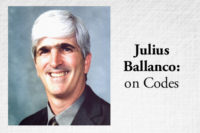For many years, I have been asked about the close relationship between IAPMO and the UA (plumbers union). Everyone wants to know whether the UA controls the Uniform Plumbing Code.
My response has always been, “No.”
However, it has always been recognized that IAPMO and the UA have close ties. While known, it was never in the forefront. One simply had to attend an IAPMO meeting to see how closely they work together. But it wasn’t spoken about publicly.
At this year’s meeting in Atlanta, this close relationship was acknowledged by the IAPMO Board and staff throughout the meeting. The UA was often thanked. Board members were introduced with their UA local identified. One colleague sitting next to me said that it appeared to be a UA lovefest. We chuckled over the comment.
Not All Bad
The colleague then clarified that it is not all bad to have such a lovefest. I had to agree. After all, the UA has a lot to offer to IAPMO and vice versa. The key is to make sure that no one group controls the codes. This is why IAPMO switched to a consensus process with balanced committees. Although the IAPMO code change process does allow for input at their annual meeting.The problem with the code change meeting at the IAPMO annual meeting is that the voting is open to all members that are present. Clearly, the UA had a majority of members present. As such, they could easily control the voting regarding code changes.
At the Annual Meeting, only the issues raised by the audience participants are discussed and voted on by the membership. This year, a mysterious list appeared at the code meeting that all of the UA representatives seemed to have and were following. On it were the code changes that someone decided the UA should oppose.
Unfortunately for the plumbing engineering community, this list contained the ASPE code changes. Those changes included a reference to ASPE 45 for siphonic roof drainage and engineered vent design using air admittance valves. The latter would be located in the Appendix under the engineered plumbing design section.
In a way, it was unfortunate that the first code change was on air admittance valves. The UA members made it clear that they don’t like air admittance valves, don’t believe they are a viable product to use and have no interest in allowing them in the Uniform Plumbing Code (UPC). This didn’t seem to surprise anyone. There were even occasional hoots and hollers against air admittance valves. The vote was overwhelming to reject the committee’s acceptance of air admittance valves.
The discussion on siphonic roof drainage was sophomoric. One of the opponents of siphonic roof drainage stated that the new section should be in the appendix under the engineered plumbing section. To support this position, the opponent stated that only designs that can be done by the plumber should be in the body of the code.
This was a rather crazy comment since every storm drainage system must be designed by a plumbing engineer. A plumber is limited to designing systems in one- and two-family dwellings. Beyond that, state laws require a licensed professional engineer to design plumbing.
That didn’t seem to matter. The code change was on the list, therefore, it was rejected by the voting membership. There really was no technical reason for objecting the proposed code change. That didn’t seem to matter, either.
Not Always Opposed
In addition to the code changes they opposed, the list also contained code changes that they wanted approved. One such change was to allow the inspector to use his or her discretion when it came to approving an alternative material or engineered design. The net effect would be that, if equivalency was proven for a new or innovative material or a special engineered design, the inspector could reject the request simply because he or she doesn’t like it. No reason would be necessary other than, “I don’t like it.”Of course, such a change completely defeats the purpose of the alternative approval and engineered design sections. It also raises questions as to whether the change in language would meet the legal requirements for alternative approval.
None of this seemed to matter. The code changes were on the list, hence, the changes were approved.
Some of the items on the list were very good. One, in particular, was a change to add back into Chapter 14 the standard for certifying installers of through-penetration protection systems. This is an ANSI/ASME A112 standard. The IAPMO Plumbing Technical Committee (TC) voted to remove this standard at their last meeting. Objections to this action were received by a myriad of TC members, including representatives of CISPI and ASPE (which happens to be me).
The vote to add this standard back into Chapter 14 received the highest vote total, with many normal code adversaries testifying and voting in agreement.
While there is an appearance that the floor vote of the membership controls the outcome of the code changes, in fact, it does not. The floor vote is merely a recommendation to the TC. The final vote is with the TC.
Within days of the end of the meeting, the TC was presented with a letter ballot on the items that were reversed by the membership vote. The TC was required to either affirm or reject the recommendation of the floor vote. In order for a floor recommendation to be approved, there must be a two-thirds majority vote by the TC.
Of the 17 floor votes to reverse the action of the TC, only two received a two-thirds majority by the TC letter ballot. One of the changes approved was the change to add to Chapter 14 the standard on certifying installers of through-penetration protection systems. The remaining 15 items that did not receive two-thirds affirmative vote will be automatically appealed to the Standards Council.


